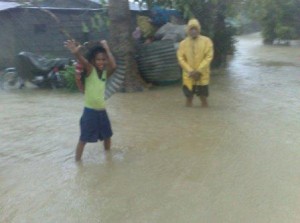Preparedness can limit the effects of certain hazards that are a result of heavy rainfall. There can be physical damage to infrastructure and casualties caused by landslides and flooding. Heavy rainfall can also damage crops which reduces supply. In the event of flooding there is the danger of electrocution because electricity passes easily through water. This is limited by unplugging all electrical appliances prior to flooding and by staying away from electrical lines.
 Flooding results in unhygienic conditions because of water contamination. Water-borne illness is caused by drinking, eating food prepared with, or from exposure of an open wound or body part (such as the eyes, ears, and nose) to contaminated water. Folded cotton reduces contamination. It is, however, not perfect. One such water borne illness is Leptospirosis, contracted from exposure to the urine or skin tissue of an infected animal. Flulike symptoms occur two to twenty-five days after exposure and include headaches, muscle aches, fever, and eye sensitivity. The second phase is a recurrence of the initial symptoms a few days after the symptoms have improved, with some infected individuals developing serious inflammation of nerves. Leptospirosis of the liver and kidneys is known as Weil’s syndrome, which causes a distinct yellowing of the eyes. Antiobiotic treatment is most effective the early in the course of the illness.
Flooding results in unhygienic conditions because of water contamination. Water-borne illness is caused by drinking, eating food prepared with, or from exposure of an open wound or body part (such as the eyes, ears, and nose) to contaminated water. Folded cotton reduces contamination. It is, however, not perfect. One such water borne illness is Leptospirosis, contracted from exposure to the urine or skin tissue of an infected animal. Flulike symptoms occur two to twenty-five days after exposure and include headaches, muscle aches, fever, and eye sensitivity. The second phase is a recurrence of the initial symptoms a few days after the symptoms have improved, with some infected individuals developing serious inflammation of nerves. Leptospirosis of the liver and kidneys is known as Weil’s syndrome, which causes a distinct yellowing of the eyes. Antiobiotic treatment is most effective the early in the course of the illness.
Water purification is one way to limit the consumption of contaminated water. Along with coal treatments and boiling of water, pouring water through folded cotton is a form of purification. Cotton purification is best when used simultaneously with other treatments. Using it without other purification processes should be a last resort because these processes are not perfect. To begin, one should use a well washed piece of cotton since the space between fibers is reduced. Fold the cotton into eight layers and cover the mouth of a container while pouring in pre-treated water or collecting surface water. To disinfect, use soap if available and leave in the sun to dry.
Another major concern with the coming rains is the spread of Malaria. This results from the growing number of mosquitoes that reproduce and flourish in moist regions, especially where there is still water. The most prone areas to malaria infection are rural areas below 600m (1970 ft). The exception to this rule of thumb is on Bohol Island, Borocay Island, Catanduanes Island, and Cebu Island. Subic Bay in particular is a high risk area for infection.
A simple precaution that halves malaria infection is the use of mosquito nets treated with indoor bug spray, such as permethrin. These insecticide treatments are able to not only kill mosquitoes on contact but repel them, which aids in reducing the presence of infected mosquitoes in the immediate area. There are insecticidal nets that need to be re-treated regularly, while long-lasting insecticidal nets are effective throughout the life of the net.
Contributed by:
Carissa Connelly
Information retrieved from:
http://www.childinfo.org/malaria.html
http://www.who.int/mediacentre/news/releases/2007/pr43/en/index.html
http://www.mdtravelhealth.com/destinations/asia/philippines.php
MD Travel Health.com
http://www.medicinenet.com/leptospirosis/article.htm

Leave a Reply